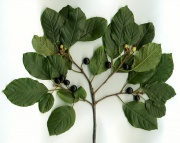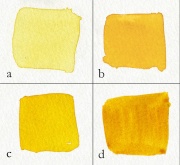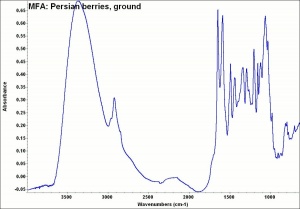Buckthorn berries
Description
Small berries from any shrub of the buckthorn family (genus Rhamnus or Frangula), especially Rhamnus infectoria. Buckthorn plants are native to the near East and have been cultivated in Europe since Roman times. A water-soluble dye was called Persian berry, extracted from the berries for use in textiles, wood stains and lake pigments. The unripe berries produce a yellow juice or sap that is used for dyeing cloth and for making a yellow pigment called sap green. The ripe berries were used to make Dutch pink, a yellow lake. The principle colorant, rhamnetin, is extracted from the dried berries by boiling water. Some plants also contain other colorants such as kaempferol (R.cartharticus), quercetin, xanthorhamnin and emodin. Sap green lake is made with alum and can vary in color from yellow to green. On wool, Persian berries produce a golden color when mordanted with chrome and a dull yellow color with an aluminum mordant. The fugitive yellow color was widely used in house paints in England. The wood from the alder buckthorn was used to make charcoal for gunpowder from the 15th-19th centuries.
Synonyms and Related Terms
buckthorn berry; Rhamnus frangula (alder buckthorn); Rhamnus cathartica (common buckthorn, purging buckthorn); Rhamnus infectoria (Avignon buckthorn); Rhamnus amygdalinus (produced China green dye); Rhamnus amygdalinus; Rhamnus oleodies; Rhamnus alaternus (Alaternus buckthorn); Rhamnus tinctoria (Dyer's buckthorn); Almindelig Trst (Dan.); Faulbaum (Deut.); sporkehout (Ned.); kruszyna pospolita (Pol.); brakved (Sven.); bayas persas (Esp.); spincervino (It.); ranno (It.); Persianberry; yellow carmine; Avignon berries; yellow berries; French berries
Other Properties
Shrubs growing to 10 m in temperate and subtropical areas. Leaves=opposite, simple elliptical (3-15 cm long). Fruit= round drupe ( 0.5 cm), black when ripe in late summer.
Additional Information
Schoch, W., Heller, I., Schweingruber, F.H., Kienast, F., 2004:Wood anatomy of central European Species: Alder Buckthorn,Frangula alnus Mill.
Authority
- Ralph Mayer, Ralph Mayer, A Dictionary of Art Terms and Techniques, Harper and Row Publishers, New York, 1969 (also 1945 printing)
- Hermann Kuhn, Hermann Kuhn, Conservation and Restoration of Works of Art and Antiquities, Butterworths, London, 1986
- F. Crace-Calvert, F. Crace-Calvert, Dyeing and Calico Printing, Palmer & Howe, London, 1876
- The Dictionary of Art, Grove's Dictionaries Inc., New York, 1996 Comment: "Pigments"
- J. Thornton, J. Thornton, 'The Use of Dyes and Colored Varnishes in Wood Polychromy', Painted Wood: History and Conservation, The Getty Conservation Insitute, Los Angeles, 1998
- G.S.Brady, G.S.Brady, Materials Handbook, McGraw-Hill Book Co., New York, 1971 Comment: p. 278
- Random House, Random House, Webster's Encyclopedic Unabridged Dictionary of the English Language, Grammercy Book, New York, 1997
- The American Heritage Dictionary or Encarta, via Microsoft Bookshelf 98, Microsoft Corp., 1998
- Thomas B. Brill, Thomas B. Brill, Light Its Interaction with Art and Antiquities, Plenum Press, New York City, 1980
- Wikipedia, the free encyclopedia, at http://www.wikipedia.com
- Art and Architecture Thesaurus Online, http://www.getty.edu/research/tools/vocabulary/aat/, J. Paul Getty Trust, Los Angeles, 2000


